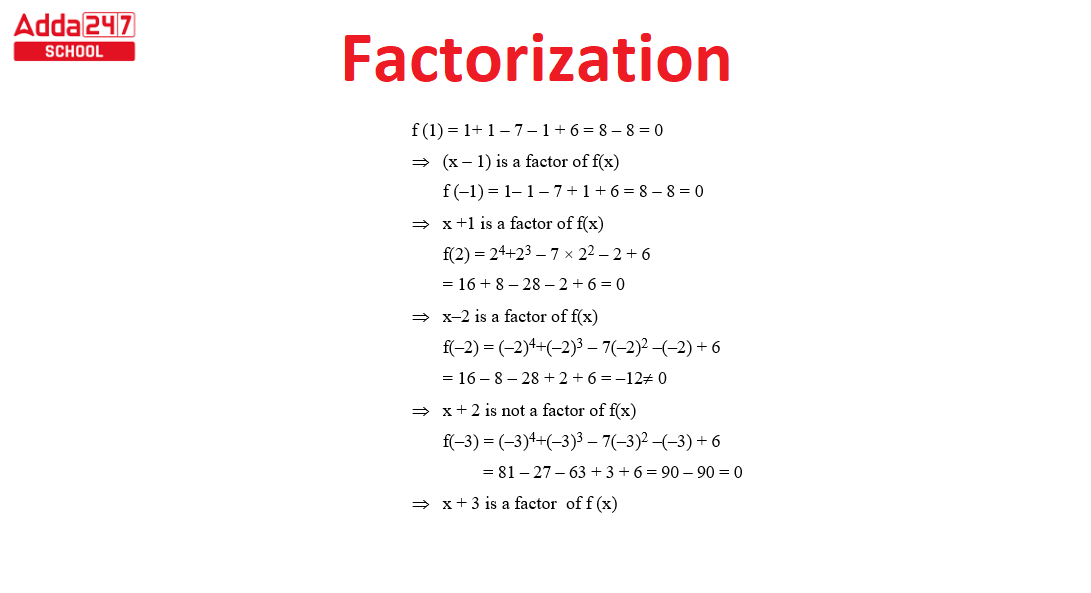Table of Contents
Factorisation: In mathematics, Factorisation or factoring is one of the most important concepts that is defined as the breaking or breakdown of a Value into a product of another entity. Factorisation is also called factoring or prime factorization (especially in the case of numbers). It is one of the most essential concepts in Mathematics. Let us now learn in detail about various concepts associated with factorisation.
Factorisation
Factorisation is the process of breaking down a mathematical entity into the product of another object known as the factors. The mathematical entity can be a number, a polynomial, or an algebraic expression. These factors when multiplied give the original mathematical entity
Factorisation Interesting Facts
Did you know that Factorisation is the process of breaking down a mathematical entity into the product of another object known as the factors? The mathematical entity can be a number, a polynomial, or an algebraic expression. In the case of numbers, these factors always result in prime numbers. Factors are also the divisors of the original mathematical entity, which when divided by any of its factors gives the remainder 0.
Meaning of Factors
Before understanding the concept of factorisation, let us familiarize ourselves with the term factors. In mathematics, the numbers or polynomials that can divide a number or a polynomial exactly without leaving any remainders are known as its factors. In other words, factors are the numbers you multiply together to obtain another number, i.e. a factor is the divisor of another number. Let us understand this with an example.
Consider the number 18. We can write 18 as a product of its factors as follows:
18 = 2x3x3
Here 2, 3, and 3 are the factors of 18.
Factorisation Definition
The factorisation is the fundamental mathematical procedure of writing an algebraic expression in the form of a product of its factors. The factors can be numbers, polynomials, or algebraic expressions. Multiplying these factors back gives the original algebraic expression.
Factorisation Examples
Some of the examples given below will help you understand the definition better.
- 24 = 2x2x2x3
- 4ab = 2x2xaxb
- a²- b² = (a + b) (a – b)
- 36ab = 2x2x3x3xaxb
Factorisation Formula
Some of the basic factorisation formulas given below will help you solve its complex concepts in a relatively short time. You should go through these formulas to have a good understanding of this mathematical procedure:
- (x + y)² = x²+ 2xy + y²
- (x – y)² = x² – 2xy + y²
- x² – y² = (x – y) (x + y)
- x³ + y³= (x + y) (x²– xy + y²)
- x³– y³ = (x – y) (x²+ xy + y²)
- (x + y + z)² = x² + y² + z² + 2xy + 2yz + 2zx
- (x – y – z)² = x²+ y²+ z²– 2xy + 2yz – 2zx
- (x + y + z)³ = x³ + y³ + z³ + 3 (x + y) (y + z) (z + x)
Factorisation Methods
Factorisation can be performed using many different methods. The factorisation method to be used for a particular algebraic expression depends on the nature of the expression or the ease of use of that particular method. The common factorisation methods include the Common Factors Method, the Method based on Regrouping Terms, Factorisation using Identities, and Factors in the form of (x + a) (x + b). Let us explore these methods one by one.
1) Common Factors Method
In this factorisation method, we extract the common factors from every term of the algebraic expression. This results in breaking that expression into its factors.
For example, 5a + 20 can be factorized using the common factors method by taking out 5 from both terms.
5a + 20 = 5 (a + 4)
So the factors of algebraic expression 5a + 20 are 5 and (a + 4)
2) Method Based on Regrouping Terms
Regrouping or rearranging the terms of an algebraic expression helps to put terms with common factors side by side grouping them together. This facilitates the extraction of a common factor from all the respective groups leading to the factorisation. It is applicable in those cases where a single common factor is not present in the algebraic expression.
For instance, consider the expression 4ab + 6a + 4b + 6. There is no single common factor that can be taken from each of the four terms. So, here we use the common factors factorisation method. We can regroup the above expression as follows:
4ab + 4b + 6a + 6
Now we can take common factors from the group of the first two terms and the remaining two terms. In doing so, we get:
4b (a + 1) + 6 (a + 1)
Now we got the common factor (a + 1) which we can extract to complete the factorisation process.
(a + 1) (4b + 6)
These are the two factors of the algebraic expression 4ab + 6a + 4b + 6.
3) Factorisation using Identities
There are many identities in mathematics using which we can easily factorise certain algebraic expressions. Some common examples of these identities are given in the Factorisation Formula section mentioned above. There are many expressions which can be written in the form of x²– y², x² + 2xy + y², etc. These expressions can be directly expressed as factors using identities. Some of these identities examples are listed below.
- Sum of Cubes
This mathematical identity is used to factorise expressions that can be expressed as the sum of perfect cubes. The algebraic expression 125 a³ + 216 b³ can be written in the form of x³ + y³ = (x + y) (x² – xy + y²).
On comparing it with the identity, we get:
x = 5a and y = 6b
So using the identity factorisation method can write the above algebraic expression as:
125 a³ + 216 b³ = (5a)³ + (6b)³ as
Or,, (5a + 6b) (25a² – 30ab + 36b²)
These are the required factors of the above algebraic expression.
- Difference of Squares
This mathematical identity is used to factorise expressions that can be expressed as the difference of perfect squares.
For example, a² – 25 can be expressed in the form of x² – y², where x = a and y = 5. So using the mathematical identity x² – y² = (x – y) (x + y), the above expression can be factored as
a² – 25 = (a)² – (5)²
So, the factors are (a – 5) (a + 5)
Some other identities using which factorisation can be achieved easily are perfect square trinomials, perfect cubes, etc.
4) Factors in the form of (x + a) (x + b)
It is one of the most common factorisation methods which is used extensively in various algebraic expressions. In this type of factorisation method, the given algebraic expression can be expressed as x² + (a + b) x + ab. In such cases, factors will always result in (x + a) (x + b).
For example, x² + 11 x + 30
On comparing the given expression with the formal identity:
a + b = 11
a x b = 30
On putting random values using the hit and trial method, we get:
a = 5 and b = 6
So, putting these values in the identity, the expression becomes
x² + (5+ 6) x + 5 x 6
= (x + 5) (x + 6)
So we get the factors in the form of (x + a) (x + b).
Factorisation of polynomials
A polynomial can be expressed as a product of its factors using the different factorisation methods mentioned above. The process of decomposing a polynomial in its factors is known as the factorisation of polynomials. It must be noted that the degree of factors of a polynomial is always less than or equal to the original polynomial.
For example, Let us consider a polynomial 16a+ 4a²
Using the common factors method of factorisation, we can take out 4a common from both the terms.
=> 4a (4 + a)
So 4a and (4 + a) are the two factors. Their degree is less than that of the polynomial.
Applications of Factorisation
Factorisation finds its applications in many different fields. Some of them have been discussed below.
- Factorisation is used to determine the roots of polynomials and to solve polynomial equations in algebra.
- Factorisation is used to demonstrate number theory principles, including the Fundamental Theorem of Arithmetic.
- The property of factorisation is used in cryptography, where it is used in public-key cryptographic algorithms like RSA.
These are all the core concepts you should know about factorisation. Mastering the information provided above will help you tackle any challenging problems related to factorisation.
Factorisation Solved Examples
Here we have provided some examples so that students can understand the concept in a better way.
Example 1: Find the factors of 25m² – 16
The algebraic expression 25m² – 16 can be written as (5m)² – (4)²
Using the factorisation using identities method of x² – y² = (x – y) (x + y), we get the following factors:
(5m – 4) (5m + 4)
Example 2: Factorise m² + 5m + 6
The given expression is analogous to the x² + (a + b) x + ab. So proceeding with this factorisation method, we get:
m² + (3 + 2)m + 3×2
This gives us the value of a as 3 and the value of b as 2. As we know its factors will be expressed as (x + a) (x + b). Putting the values we obtain its factors as,
(m + 3) (m + 2)
Example 3: Factorise the polynomial 4a² + 12a + 3a + 9
As there is no common factor, we can solve this problem by using the regrouping terms method of factorisation.
=> 4a² + 12a + 3a + 9
=> 4a (a + 3) + 3 (a + 3)
=> (4a + 3) (a + 3)
So the factors are (4a + 3) (a + 3)
Example 4: Find the factors of 14pqr
As it contains only a single term, it can be solved by prime factorisation methods.
14pqr = 2x7xpxqxr
So the factors are 2, 7, p, q, and r.



 NEET UG 2025: Is NEET Previous years Que...
NEET UG 2025: Is NEET Previous years Que...
 JEE Mains Session 2 Result 2025 OUT, Sco...
JEE Mains Session 2 Result 2025 OUT, Sco...
 TS Inter Results 2025 Date for TSBIE 1st...
TS Inter Results 2025 Date for TSBIE 1st...










